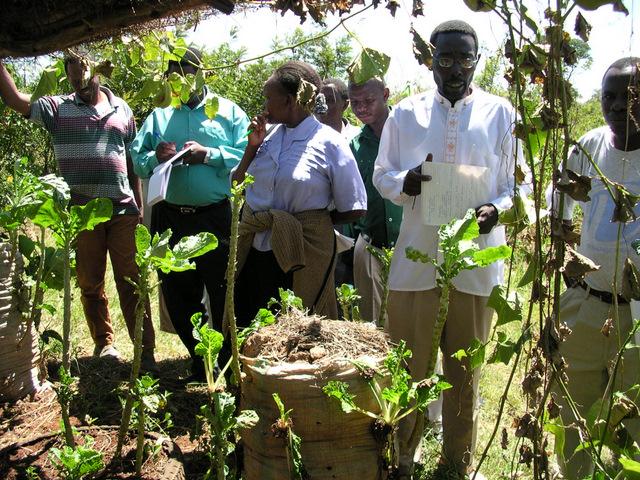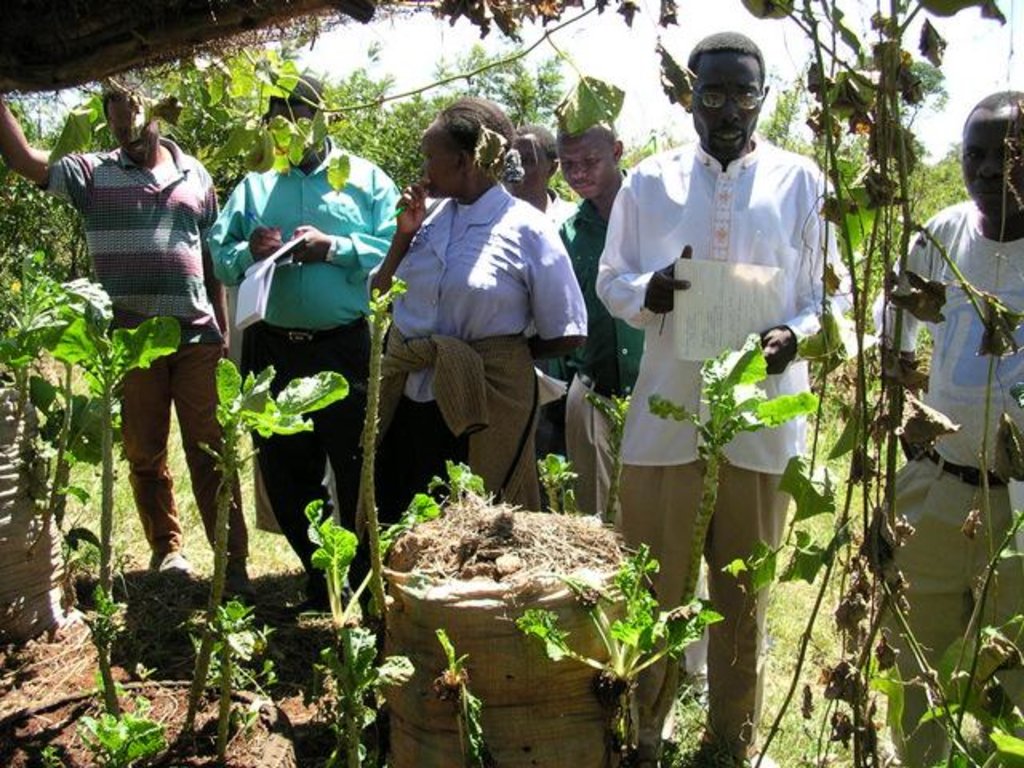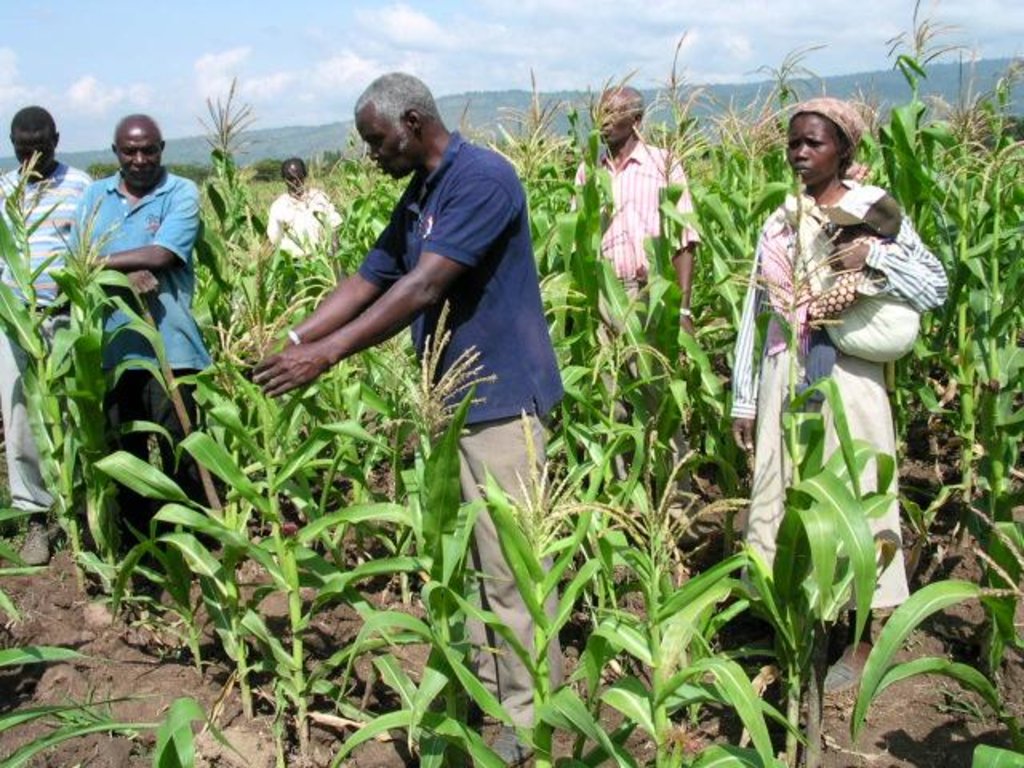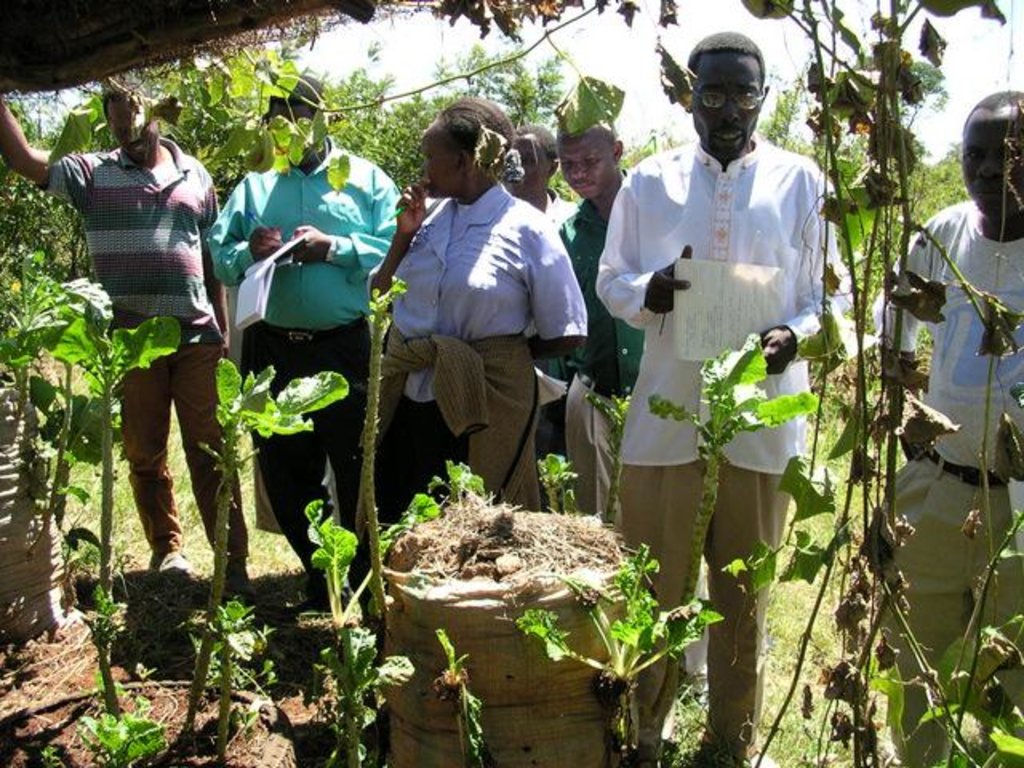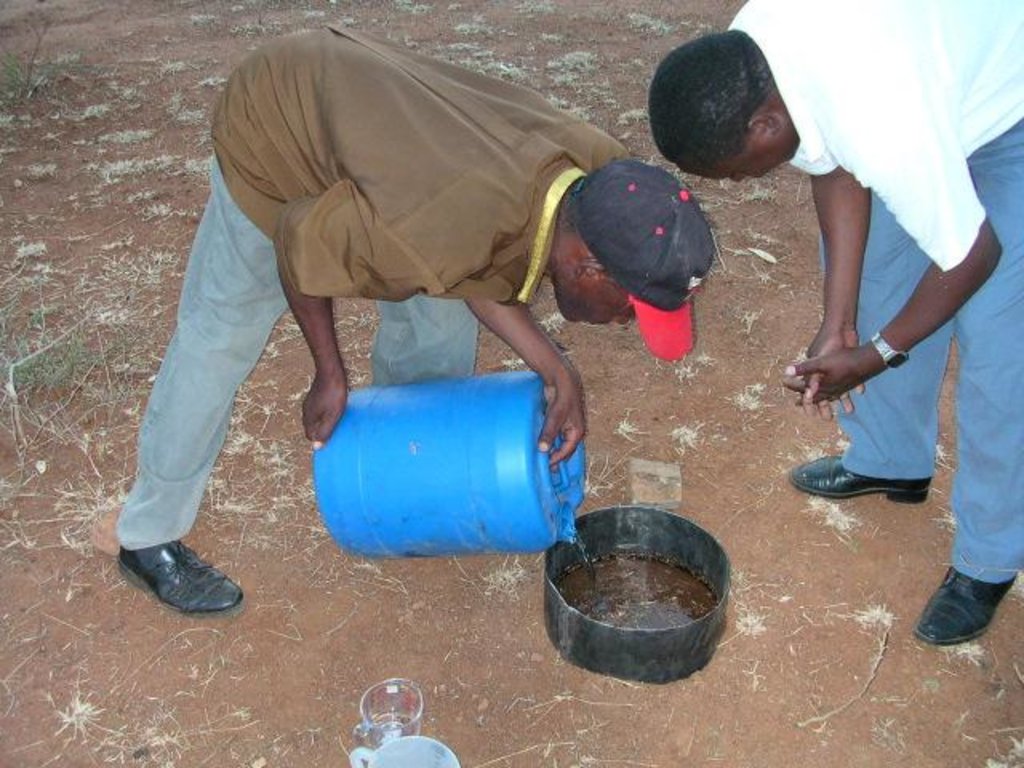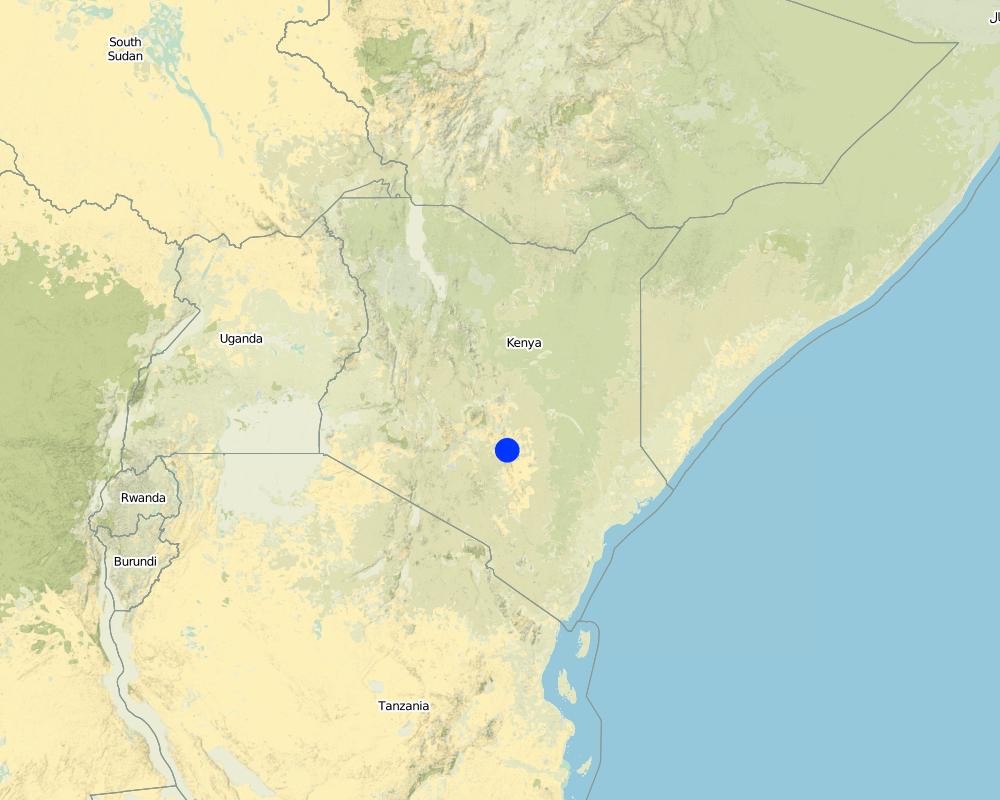Farmer Field Schools [Quênia]
- Criação:
- Atualização:
- Compilador/a: Philippe Zahner
- Editor: –
- Revisor: Fabian Ottiger
approaches_2569 - Quênia
Veja as seções
Expandir tudo Recolher tudo1. Informação geral
1.2 Detalhes do contato das pessoas capacitadas e instituições envolvidas na avaliação e documentação da abordagem
Especialista em GST:
Duveskog Deborah
deborah.duveskog@gmail.com
FAO
Quênia
Especialista em GST:
Nome da(s) instituição(ões) que facilitou(ram) a documentação/avaliação da Abordagem (se relevante)
FAO Food and Agriculture Organization (FAO Food and Agriculture Organization) - ItáliaNome da(s) instituição(ões) que facilitou(ram) a documentação/avaliação da Abordagem (se relevante)
Swiss Agency for Development and Cooperation (DEZA / COSUDE / DDC / SDC) - Suíça1.3 Condições em relação ao uso da informação documentada através de WOCAT
O compilador e a(s) pessoa(s) capacitada(s) aceitam as condições relativas ao uso de dados documentados através do WOCAT:
Sim
1.4 Referência ao(s) questionário(s) sobre tecnologias da GST
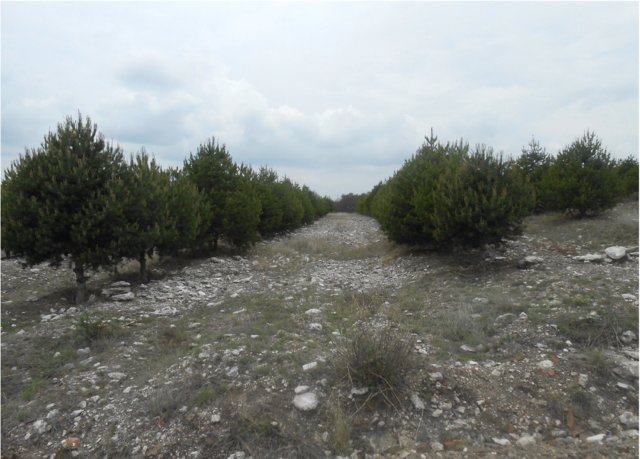
Callejones de piñón con forrajes intercalados [México]
La tecnología consiste en un sistema agrosilvopastoril con árboles de Pinus cembroides (pino piñonero) alineados een bordos ─en un terreno con suelos calizos previamente subsoleado─ conformando melgas (callejones) para con cultivos anuales para grano y forraje, con pastoreo libre eventual por períodos muy breves.
- Compilador/a: BENJAMIN SANCHEZ BERNAL
2. Descrição da abordagem de GST
2.1 Descrição curta da abordagem
A Farmer Field School (FFS) is a community-based practically-oriented field study programme.
2.2 Descrição detalhada da abordagem
Descrição detalhada da abordagem:
Aims / objectives: It is usually a time-bound activity (generally one agricultural production cycle), involving a group (commonly 20-30) of farmers, facilitated by agricultural advisors or – increasingly – by other farmers. The FFS provides an opportunity for farmers to learn together, using practical, hands-on methods of discovery-based and participatory learning.
Methods: The methods emphasise observation, discussion, analysis, collective decision-making, presentation and taking appropriate action. Discussion and analysis are important ways to combine local indigenous knowledge with new concepts and bring both into decision-making. The aim is to develop participants’ decision-making and problem solving capacity among farmers. The process builds self-confidence (particularly for women), encourages group control of the process, and builds management and leadership skills. Although FFS are time-bound, many groups formalise their relations and continue study or action projects, including FFS on other subjects, after the FFS learning cycle is completed. The Farmer Field Schools on Integrated Land and Water Management (ILWM) in eastern and central Kenya focus on learning about how to improve management of land and water resources both on individual plot and farm level and within ‘landscapes’ and communal lands; including local watersheds, river-valleys, forested hill-tops, grazing lands, eroded gullies etc. Each FFS group experiments practically on selected SLM practices/ measures. All learning takes place in the field and farmers usually meet once per week at a selected host farm in their locality to monitor their field experiments and to discuss emerging issues. Trained facilitators, usually agricultural advisors, guide farmers in their observation and analysis of what is taking place in the field. Local farmer innovations are identified to feed indigenous knowledge into the FFS process: Innovators visit FFS groups or FFS members visit innovators farms to share their knowledge.
Other important information: The FFS process combined with the promotion of farmer innovation has proven to contribute to strong and cohesive groups that are able to make informed decisions and change cultural and practical behaviour in order to improve their production and land management. The process also builds self-confidence, and empowers especially women to take on leadership roles in the community. The impacts observed of FFS thus have strong biophysical and social dimensions.
2.3 Fotos da abordagem
2.5 País/região/locais onde a abordagem foi aplicada
País:
Quênia
Região/Estado/Província:
Eastern and Central Kenya
Especificação adicional de localização:
Mwingi, Kitui and Nakuru Districts
Map
×2.7 Tipo de abordagem
- Baseado em projeto/programa
2.8 Principais metas/objetivos da abordagem
The Approach focused mainly on SLM with other activities (community organisational building for collective action and collective storage and marketing of products)
Support farmers’ knowledge levels and decision making capacity in relation to sustainable land and water management Raise farmers’ yields in a sustainable manner and ultimately contribute to increased net farm income Strengthen community organisation and collective efforts
The SLM Approach addressed the following problems: Land degradation, climatic variability and loss of agricultural biodiversity, Farmers focus on their own farms and income and lack of interest for wider watershed / environment
3. Participação e papel das partes interessadas envolvidas
3.1 Partes interessadas envolvidas na abordagem e seus papéis
- Usuários de terra/comunidades locais
- Especialistas em GST/ consultor agrícola
- Governo nacional (planejadores, responsáveis pelas decisões)
Ministry of Agriculture
- Organização internacional
FAO
3.2 Envolvimento do usuários de terra/comunidades locais nas diferentes fases da abordagem
| Envolvimento do usuários de terra/comunidades locais | Especifique quem estava envolvido e descreva as atividades | |
|---|---|---|
| Iniciação/motivação | Participativo | |
| Planejamento | Participativo | |
| Implementação | Participativo | |
| Monitoramento/avaliação | Nenhum | |
| Research | Nenhum |
3.4 Decisão sobre a seleção de tecnologia/tecnologias de GST
Especifique quem decidiu sobre a seleção de tecnologia/tecnologias a serem implementadas:
- Principalmente usuários da terra, apoiados por especialistas em GST
Explique:
Decisions on the method of implementing the SLM Technology were made by mainly by land users supported by SLM specialists
4. Suporte técnico, reforço das capacidades e gestão do conhecimento
4.1 Reforço das capacidades/formação
Foi oferecida formação aos usuários da terra/outras partes interessadas?
Sim
Especifique quem foi capacitado:
- Usuários de terra
- Equipe de campo/consultores
Tipo de formação:
- Agricultor para agricultor
- Cursos
Assuntos abordados:
Agricultural advisors were trained in the FFS approach and in ILWM topics through a total of four weeks of training. Farmers were trained in FFS through season-long FFS learning where farmers meet at a host-farm weekly to carry study activities.
4.2 Serviço de consultoria
Os usuários de terra têm acesso a um serviço de consultoria?
Sim
Especifique se foi oferecido serviço de consultoria:
- nas áreas dos usuários da terra
Descreva/comentários:
Name of method used for advisory service: Participatory extension; Participatory extension with season-long regular interaction between farmers and agricultural advisors. At a later stage also strong farmer-to-farmer extension
The approach requires an attitude shift among agricultural extension workers to become more client-orientated.
4.5 Pesquisa
A pesquisa foi parte da abordagem?
Sim
5. Financiamento e apoio material externo
5.1 Orçamento anual para o componente de GST da abordagem
Caso o orçamento exato seja desconhecido, indique a faixa:
- 100.000-1.000.000
Comentários (p. ex. principais fontes de recursos/principais doadores):
Approach costs were met by the following donors: international: 60.0%; government: 20.0%; local community / land user(s): 20.0%
5.3 Subsídios para entradas específicas (incluindo mão-de-obra)
Se a mão-de-obra pelos usuários da terra foi uma entrada substancial, isso foi:
- Voluntário
5.4 Crédito
Foi concedido crédito segundo a abordagem para atividades de GST?
Não
6. Análise de impactos e declarações finais
6.1 Impactos da abordagem
A abordagem auxiliou os usuários da terra a implementar e manter as tecnologias de GST?
- Não
- Sim, pouco
- Sim, moderadamente
- Sim, significativamente
yield increase of more than 200% has been recorded frequently
Did other land users / projects adopt the Approach?
- Não
- Sim, pouco
- Sim, moderadamente
- Sim, significativamente
the applied practices have spread from participants to neighbours in the community
Did the Approach lead to improved livelihoods / human well-being?
- Não
- Sim, pouco
- Sim, moderadamente
- Sim, significativamente
improved gender relations and division of farm workload, resistance to drought and improved livelihoods and life satisfaction in general
Did the Approach help to alleviate poverty?
- Não
- Sim, pouco
- Sim, moderadamente
- Sim, significativamente
all participants fall in the poor or medium poor category and therefore the project has contributed to reduced poverty levels
6.2 Principal motivação dos usuários da terra para implementar a GST
- Produção aumentada
- Lucro (lucrabilidade) aumentado, melhora da relação custo-benefício
- Prestígio, pressão social/coesão social
- Afiliação a movimento/projeto/grupo/rede
- friendship and collective spirit among group membe
6.3 Atividades de sustentabilidade de abordagem
Os usuários da terra podem manter o que foi implementado através da abordagem (sem apoio externo)?
- Sim
Caso afirmativo, descreva como:
Graduated FFS groups have organised themselves into a network and farmer organisations that have taken on collective activities following the end of the initial project. In some cases this has included starting up self-financed new FFS groups.
6.4 Pontos fortes/vantagens da abordagem
| Pontos fortes/vantagens/oportunidades na visão do compilador ou de outra pessoa capacitada |
|---|
| The collective action created in communities to deal with and manage their own resources. |
| Improved capacity of farmers for problem solving and innovation in ISWM. |
6.5 Pontos fracos, desvantagens da tecnologia e formas de superá-los
| Pontos fracos/vantagens/riscos na visão do compilador ou de outra pessoa capacitada | Como eles podem ser superados? |
|---|---|
| A top-down and patronising attitude towards farmers are common among agricultural staff and experts, which prevents equal and trustful relationships | Institutionalisation of participatory extension is thus needed with a change in mindset among government and other agricultural support staff. |
| The various government bodies and ministries responsible for land and water issue often operate individually without strong synergie | A stronger collaboration is needed between ministries especially Ministry of Water and Ministry of Agriculture in order to deal effectively with land and water aspects in an integrated manner. |
7. Referências e links
7.1 Métodos/fontes de informação
- visitas de campo, pesquisas de campo
- entrevistas com usuários de terras
7.2 Referências às publicações disponíveis
Título, autor, ano, ISBN:
Duveskog D. 2001. Adapted from A Study Guide for Farmer Field Schools: Water Harvesting and Soil Moisture Retention.FAO-IIRR. 2006. Discovery-based Learning on Land and Water Management: Practical Guide for Farmer Field Schools.
Links e módulos
Expandir tudo Recolher tudoLinks

Callejones de piñón con forrajes intercalados [México]
La tecnología consiste en un sistema agrosilvopastoril con árboles de Pinus cembroides (pino piñonero) alineados een bordos ─en un terreno con suelos calizos previamente subsoleado─ conformando melgas (callejones) para con cultivos anuales para grano y forraje, con pastoreo libre eventual por períodos muy breves.
- Compilador/a: BENJAMIN SANCHEZ BERNAL
Módulos
Não há módulos


